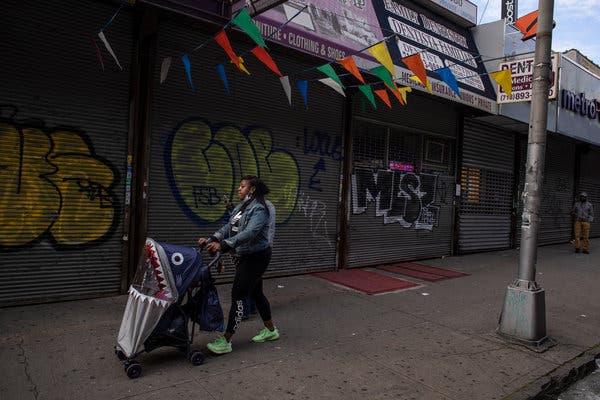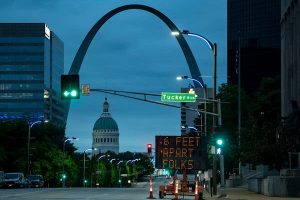Weather: Increasingly sunny, with a breeze. High in the mid-60s.
Alternate-side parking is in effect on Wednesday and then suspended on Thursday for Solemnity of the Ascension. It is in effect on Friday and Saturday, and then suspended through June 7. The city may extend the suspension past June 7 based on street cleanliness and the availability of the work force.
Some hospitals will allow visits to resume, in a pilot program.
For families of coronavirus patients in New York, one of the pandemic’s most heartbreaking aspects has been the inability to visit loved ones who are hospitalized.
Visitors have been all but forbidden at hospitals across the state since March 18, when officials asked that visits be suspended as the virus spread.
Thousands of relatives of dying patients have had to say their last goodbyes over the phone, via a tablet screen or not at all.
Now, with the virus on the wane, Gov. Andrew M. Cuomo said on Tuesday that the state would allow visitors at 16 hospitals, nine of them in New York City, as part of a pilot program.
The hospitals include Jacobi Medical Center in the Bronx, Maimonides Medical Center in Brooklyn and Mount Sinai hospitals in Queens and Manhattan. (See the complete list.)
“It is terrible to have someone in the hospital and then that person is isolated, not being able to see their family or friends,” Mr. Cuomo said.
[Get the latest news and updates on the coronavirus in the New York region.]
N.Y.U. plans to hold in-person classes, ‘with great care,’ this fall.
New York University plans to hold in-person classes in the fall, the university’s provost said on Tuesday, as other institutions of higher education weighed how to proceed amid the pandemic.
“We’re planning to convene in person, with great care, in the fall (subject to government health directives), both in New York and at our global sites,” the provost, Katherine Fleming, wrote in a letter to incoming freshmen.
Still, Ms. Fleming added: “I can’t pretend that 2020-21 will be a typical academic year.”
The announcement paves the way for a major university in the heart of New York City to invite thousands of undergraduates into what has been the U.S. epicenter of a global health crisis, with health and safety measures in place.
The move comes as other colleges and universities in the region and across the country continue to explore when and how to reopen their campuses over the summer and try to plan for an influx of students in the fall.
Also in New York City, nearly 16 percent of the 1.1 million public school students will be asked to attend online summer school for about six weeks. That’s about four times the percentage from last year.
The school year is set to end on June 26. Students who have fallen behind in courses will be notified about their summer school placements before then.
[Coronavirus in New York: A map and the case count.]
N.Y.C. health commissioner resurfaces after controversies.
The appearance on Tuesday of New York City’s health commissioner at Mayor Bill de Blasio’s daily briefing on the pandemic would not ordinarily have been remarkable.
But the commissioner, Dr. Oxiris Barbot, had been absent from the briefings for nearly a week, after missing only four of 60 since the outbreak started. And questions had begun to swirl over whether Mr. de Blasio had sidelined her.
Dr. Barbot had undoubtedly hit a rough patch.
On May 7, The New York Times reported that Mr. de Blasio had shifted the job of contact tracing for the virus out of the Health Department, which has historically led such efforts, and to the agency that runs the city’s public hospitals.
About a week later, The New York Post reported that in March, during the outbreak’s chaotic early days, Dr. Barbot and a police commander had a heated confrontation over the distribution of personal protective gear to health care workers and police officers.
Dr. Barbot, The Post reported, told the commander, “I don’t give two rats’ asses about your cops.”
The mayor pointedly said at a news conference on Friday that he had not spoken to Dr. Barbot in “a couple of days.” She did not attend a City Council hearing about contact tracing that day.
On Monday, Dr. Barbot apologized publicly for the comments about the police. And on Tuesday, she was back for the daily briefing, participating by video link.
What we’re reading
The Metropolitan Transportation Authority is rolling out 230 ultraviolet lamps on subways and buses to help eradicate the coronavirus. [New York Post]
-
Frequently Asked Questions and Advice
Updated May 12, 2020
-
Is ‘Covid toe’ a symptom of the disease?
There is an uptick in people reporting symptoms of chilblains, which are painful red or purple lesions that typically appear in the winter on fingers or toes. The lesions are emerging as yet another symptom of infection with the new coronavirus. Chilblains are caused by inflammation in small blood vessels in reaction to cold or damp conditions, but they are usually common in the coldest winter months. Federal health officials do not include toe lesions in the list of coronavirus symptoms, but some dermatologists are pushing for a change, saying so-called Covid toe should be sufficient grounds for testing.
-
How do I take my temperature?
Taking one’s temperature to look for signs of fever is not as easy as it sounds, as “normal” temperature numbers can vary, but generally, keep an eye out for a temperature of 100.5 degrees Fahrenheit or higher. If you don’t have a thermometer (they can be pricey these days), there are other ways to figure out if you have a fever, or are at risk of Covid-19 complications.
-
What should I do if I feel sick?
If you’ve been exposed to the coronavirus or think you have, and have a fever or symptoms like a cough or difficulty breathing, call a doctor. They should give you advice on whether you should be tested, how to get tested, and how to seek medical treatment without potentially infecting or exposing others.
-
When will this end?
This is a difficult question, because a lot depends on how well the virus is contained. A better question might be: “How will we know when to reopen the country?” In an American Enterprise Institute report, Scott Gottlieb, Caitlin Rivers, Mark B. McClellan, Lauren Silvis and Crystal Watson staked out four goal posts for recovery: Hospitals in the state must be able to safely treat all patients requiring hospitalization, without resorting to crisis standards of care; the state needs to be able to at least test everyone who has symptoms; the state is able to conduct monitoring of confirmed cases and contacts; and there must be a sustained reduction in cases for at least 14 days.
-
How can I help?
Charity Navigator, which evaluates charities using a numbers-based system, has a running list of nonprofits working in communities affected by the outbreak. You can give blood through the American Red Cross, and World Central Kitchen has stepped in to distribute meals in major cities.
-
Should I wear a mask?
The C.D.C. has recommended that all Americans wear cloth masks if they go out in public. This is a shift in federal guidance reflecting new concerns that the coronavirus is being spread by infected people who have no symptoms. Until now, the C.D.C., like the W.H.O., has advised that ordinary people don’t need to wear masks unless they are sick and coughing. Part of the reason was to preserve medical-grade masks for health care workers who desperately need them at a time when they are in continuously short supply. Masks don’t replace hand washing and social distancing.
-
How do I get tested?
If you’re sick and you think you’ve been exposed to the new coronavirus, the C.D.C. recommends that you call your healthcare provider and explain your symptoms and fears. They will decide if you need to be tested. Keep in mind that there’s a chance — because of a lack of testing kits or because you’re asymptomatic, for instance — you won’t be able to get tested.
-
How does coronavirus spread?
It seems to spread very easily from person to person, especially in homes, hospitals and other confined spaces. The pathogen can be carried on tiny respiratory droplets that fall as they are coughed or sneezed out. It may also be transmitted when we touch a contaminated surface and then touch our face.
-
Is there a vaccine yet?
No. Clinical trials are underway in the United States, China and Europe. But American officials and pharmaceutical executives have said that a vaccine remains at least 12 to 18 months away.
-
What makes this outbreak so different?
Unlike the flu, there is no known treatment or vaccine, and little is known about this particular virus so far. It seems to be more lethal than the flu, but the numbers are still uncertain. And it hits the elderly and those with underlying conditions — not just those with respiratory diseases — particularly hard.
-
What if somebody in my family gets sick?
If the family member doesn’t need hospitalization and can be cared for at home, you should help him or her with basic needs and monitor the symptoms, while also keeping as much distance as possible, according to guidelines issued by the C.D.C. If there’s space, the sick family member should stay in a separate room and use a separate bathroom. If masks are available, both the sick person and the caregiver should wear them when the caregiver enters the room. Make sure not to share any dishes or other household items and to regularly clean surfaces like counters, doorknobs, toilets and tables. Don’t forget to wash your hands frequently.
-
Should I stock up on groceries?
Plan two weeks of meals if possible. But people should not hoard food or supplies. Despite the empty shelves, the supply chain remains strong. And remember to wipe the handle of the grocery cart with a disinfecting wipe and wash your hands as soon as you get home.
-
Can I go to the park?
Yes, but make sure you keep six feet of distance between you and people who don’t live in your home. Even if you just hang out in a park, rather than go for a jog or a walk, getting some fresh air, and hopefully sunshine, is a good idea.
-
Should I pull my money from the markets?
That’s not a good idea. Even if you’re retired, having a balanced portfolio of stocks and bonds so that your money keeps up with inflation, or even grows, makes sense. But retirees may want to think about having enough cash set aside for a year’s worth of living expenses and big payments needed over the next five years.
-
What should I do with my 401(k)?
Watching your balance go up and down can be scary. You may be wondering if you should decrease your contributions — don’t! If your employer matches any part of your contributions, make sure you’re at least saving as much as you can to get that “free money.”
-
The Queens district attorney and the acting borough president will host a virtual Memorial Day observance ceremony. [QNS.com]
A dumpling shop set to open in July in the East Village will use automat service — where customers can order and get food without interacting with anyone. [Eater New York]
And finally: Quarantine and a ring
The Times’s Charanna Alexander writes:
For many people, a marriage proposal involves months of planning, ring shopping and, of course, creating the perfect moment for that ultimate surprise. But when the coronavirus started to spread globally, followed by stay-at-home guidelines and the closure of restaurants and public spaces, plans to propose in exotic locales or fancy restaurants came to a screeching halt.
Many quarantined couples, however, decided to press on with their plans.
Christopher Bent of New York told The Times:
The whole city was on lockdown, so I decided to lock this down, too. At a time when everyone has to categorize what is essential in life or not, it’s easy to see who is essential in your own life. We got engaged on March 20, on our apartment building’s rooftop surrounded by the skyline, with a bottle of champagne and zero bystanders.
Daniel MacGregor, also a New Yorker, wrote:
My girlfriend, Paulina, and I decided to have a romantic dinner to celebrate us having lived together for three years. Halfway through dinner, Paulina started to say that she was grateful that I came back to New York from Mexico to be with her during the pandemic. My dad had needed surgery, and I’d spent a few weeks in Mexico (where we’re both from) to be with my dad and my family. While there, the pandemic broke out.
It was important to me that we stay together, so I traveled back to New York on March 21. During our dinner on April 1, I had the engagement ring hidden inside a box of Flanax, so I went to get it from the desk drawer and Paulina was confused as to why I needed medicine so abruptly while she was speaking. I got the ring out from the box of medicine and got down on one knee. We both started laughing and crying. I asked her if she wanted to marry me, and she said yes.
It’s Wednesday — surprise someone.
Metropolitan Diary: Losing it
Dear Diary:
It was January, and I was home from college visiting my father on the Upper West Side.
While I was in New York, I relished making plans way downtown that would give me the chance to get a good stroll in. Unfortunately, that often meant braving the madness of Midtown.
On one chilly night, I was near 39th Street when a huge truck swerved around some parked cars and pulled up to a red light way too close to me.
I lost it. Pure rage. Every curse I could string together flew out of my mouth. I even banged the side of the truck’s cab with my open palm.
I could see the steam pulsing off me as I waited for the driver’s response. I was ready to escalate.
But after a beat, he smiled.
“That was pretty good,” he said through the truck’s open window.
My fury dissipated immediately. And as it did, a new warmth filled my cheeks. Pride.
I loosened my scarf and kept walking downtown, leaving Midtown’s mad heat behind.
— Victoria Bata
New York Today is published weekdays around 6 a.m. Sign up here to get it by email. You can also find it at nytoday.com.
We’re experimenting with the format of New York Today. What would you like to see more (or less) of? Post a comment or email us: [email protected].



















